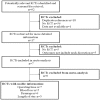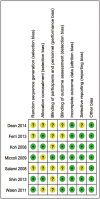The Harmonic Scalpel versus Conventional Hemostasis for Neck Dissection: A Meta-Analysis of the Randomized Controlled Trials
- PMID: 26161897
- PMCID: PMC4498925
- DOI: 10.1371/journal.pone.0132476
The Harmonic Scalpel versus Conventional Hemostasis for Neck Dissection: A Meta-Analysis of the Randomized Controlled Trials
Abstract
Objective: Neck dissection is the most definitive and effective treatment for head and neck cancer. This systematic review aims to compare the efficacy and surgical outcomes of neck dissection between the harmonic scalpel and conventional surgical techniques and conduct a quantitative meta-analysis of the randomized trials.
Methods: Randomized controlled trials (RCTs) were identified from the major electronic databases (MEDLINE, EMBASE and Cochrane Library) using the keywords ''harmonic scalpel'' and ''neck dissection,'' and a quantitative meta-analysis was conducted. The operative time and intraoperative bleeding were the primary outcome measures, and other parameters assessed included the drainage fluid volume and length of hospital stay.
Results: Seven trials that met the inclusion criteria included 406 neck dissection cases (201 in the harmonic scalpel group). Compared with conventional surgical techniques, the HS group had an operative time that was significantly reduced by 29.3 minutes [mean difference: -29.29; 95% CI = (-44.26, -14.32); P=0.0001], a reduction in intraoperative bleeding by 141.1 milliliters [mean difference: -141.13; 95% CI = (-314.99, 32.73); P=0.11], and a reduction in drainage fluid volume by 64.9 milliliters [mean difference: -64.86; 95% CI = (-110.40, -19.32); P=0.005] , but it is not significant after removal of studies driving heterogeneity. There was no significant difference in the length of the hospital stay [mean difference: -0.21; 95% CI = (-0.48, 0.07); P=0.14].
Conclusion: This systematic review showed that using the harmonic scalpel for neck dissection significantly reduces the operative time and drainage fluid volume and that it is not associated with an increased length of hospital stay or perioperative complications. Therefore, the harmonic scalpel method is safe and effective for neck dissection. However, the statistical heterogeneity was high. Further studies are required to substantiate our findings.
Conflict of interest statement
Figures









Similar articles
-
Harmonic scalpel versus conventional haemostasis in neck dissection: a prospective randomized study.Int J Surg Oncol. 2013;2013:369345. doi: 10.1155/2013/369345. Epub 2013 Dec 22. Int J Surg Oncol. 2013. PMID: 24490063 Free PMC article. Clinical Trial.
-
Complications in thyroid surgery. Harmonic Scalpel, Harmonic Focus versus Conventional Hemostasis: A meta-analysis.Int J Surg. 2016 Apr;28 Suppl 1:S22-32. doi: 10.1016/j.ijsu.2015.12.050. Epub 2016 Jan 6. Int J Surg. 2016. PMID: 26768409 Review.
-
The harmonic scalpel versus electrocautery for parotidectomy: A meta - analysis.J Craniomaxillofac Surg. 2019 Jun;47(6):915-921. doi: 10.1016/j.jcms.2019.01.008. Epub 2019 Jan 10. J Craniomaxillofac Surg. 2019. PMID: 30954384
-
Is Using the Harmonic Scalpel Better than Conventional Hemostasis in Neck Dissection? A Meta-Analysis.Craniomaxillofac Trauma Reconstr. 2024 Mar;17(1):74-86. doi: 10.1177/19433875231170924. Epub 2023 Apr 15. Craniomaxillofac Trauma Reconstr. 2024. PMID: 38371216 Free PMC article.
-
Neck dissection with harmonic scalpel and electrocautery? A randomised study.Auris Nasus Larynx. 2017 Oct;44(5):590-595. doi: 10.1016/j.anl.2016.11.004. Epub 2016 Dec 20. Auris Nasus Larynx. 2017. PMID: 28010943 Clinical Trial.
Cited by
-
An umbrella review of the surgical performance of Harmonic ultrasonic devices and impact on patient outcomes.BMC Surg. 2023 Jun 29;23(1):180. doi: 10.1186/s12893-023-02057-9. BMC Surg. 2023. PMID: 37386399 Free PMC article.
-
E-cadherin expression and prognosis of head and neck squamous cell carcinoma: evidence from 19 published investigations.Onco Targets Ther. 2016 Apr 26;9:2447-53. doi: 10.2147/OTT.S98577. eCollection 2016. Onco Targets Ther. 2016. PMID: 27217768 Free PMC article.
-
CD73 is associated with poor prognosis in HNSCC.Oncotarget. 2016 Sep 20;7(38):61690-61702. doi: 10.18632/oncotarget.11435. Oncotarget. 2016. PMID: 27557512 Free PMC article.
-
Clinical analysis of neck node metastasis in oral cavity cancer.J Korean Assoc Oral Maxillofac Surg. 2018 Dec;44(6):282-288. doi: 10.5125/jkaoms.2018.44.6.282. Epub 2018 Dec 28. J Korean Assoc Oral Maxillofac Surg. 2018. PMID: 30637242 Free PMC article.
-
Unit resection of buccal squamous cell carcinoma: Description of a new surgical technique.Oncotarget. 2016 Dec 25;8(32):52420-52431. doi: 10.18632/oncotarget.14191. eCollection 2017 Aug 8. Oncotarget. 2016. PMID: 28881740 Free PMC article.
References
-
- Gall AM, Sessions DG, Ogura JH. Complications following surgery for cancer of the larynx and hypopharynx. Cancer. 1977; 39(2):624–631. - PubMed
-
- Girod A, Brancati A, Mosseri V, Kriegel I, Jouffroy T, Rodriguez J. Study of the length of hospital stay for free flap reconstruction of oral and pharyngeal cancer in the context of the new French casemix-based funding. Oral Oncol. 2010; 46(3):190–194. 10.1016/j.oraloncology.2009.12.002 - DOI - PubMed
Publication types
MeSH terms
Grants and funding
LinkOut - more resources
Full Text Sources
Other Literature Sources
Miscellaneous

